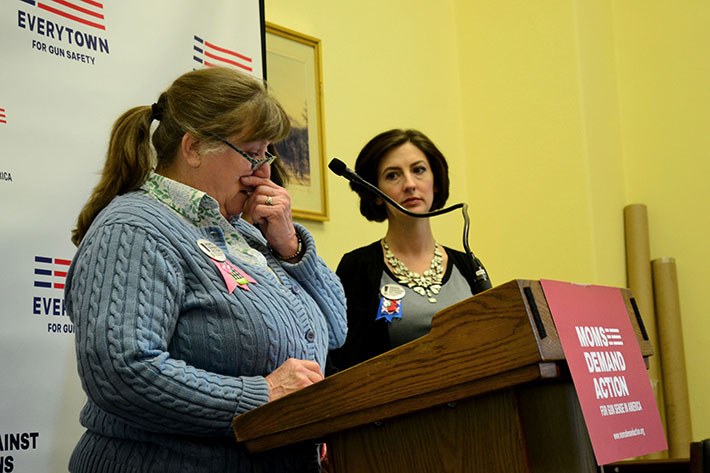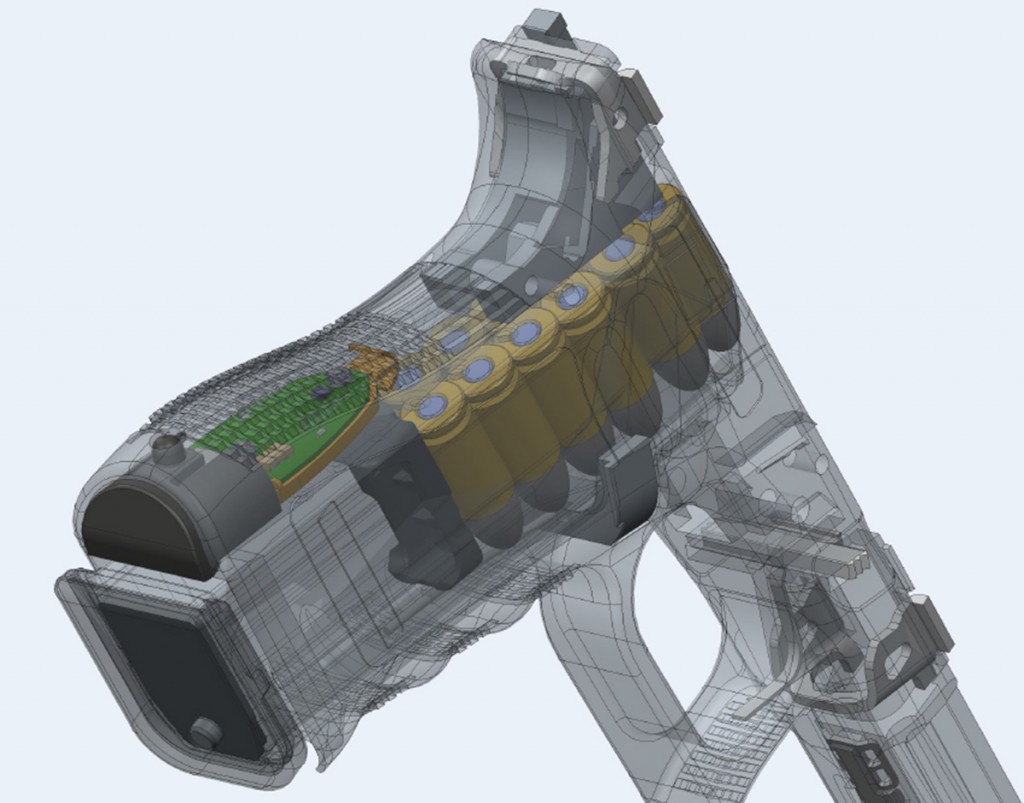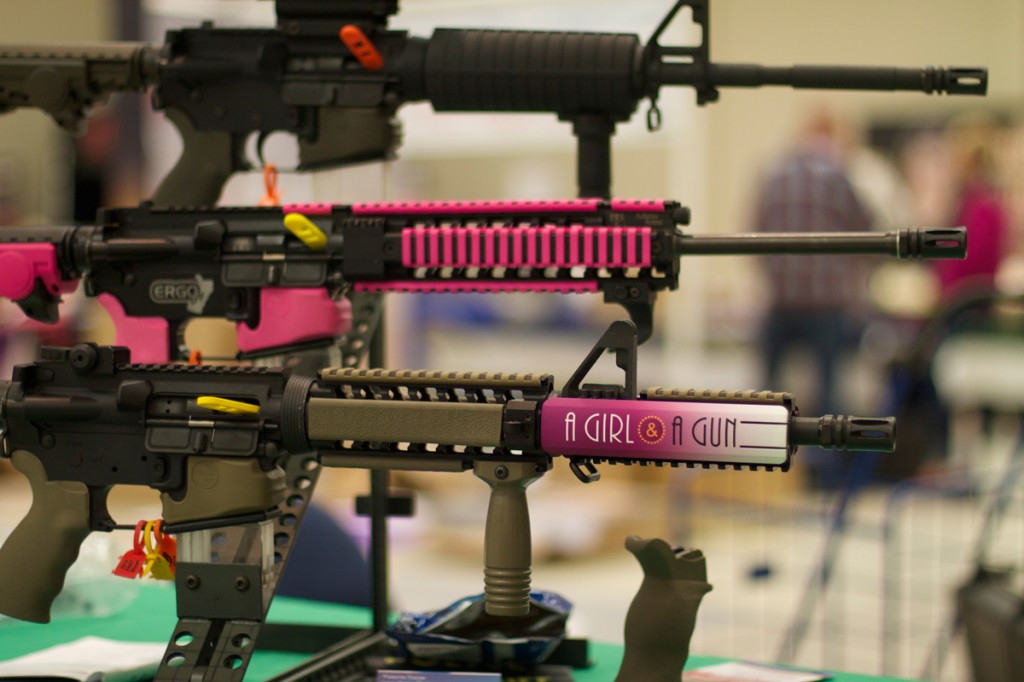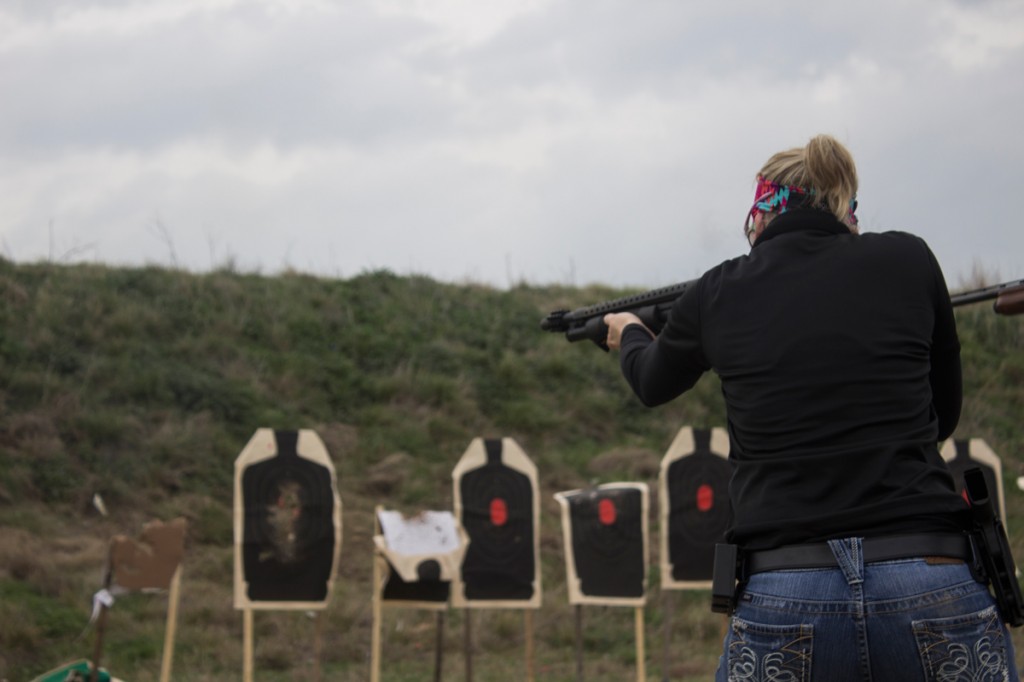Moms meet in Washington to urge action on gun control
Posted May 15, 2014
Sonja Woods chokes up during the “Moms Take The Hill” event on May 7 in Washington as she speaks about her daughter, Catherine, who was murdered at age 26. (Photo by Justine McDaniel, News21)
By Sarah Ferris
The man who killed Sonja Woods’ 26-year-old daughter had once been committed to a state mental hospital and was not legally allowed to own a gun.
After three failed attempts to purchase one, 32-year-old Justin Schiller found a local hardware store that sold him a semiautomatic pistol without a background check.
Weeks later, Schiller fired 14 bullets into the side of Catherine Wood’s car, killing her almost instantly. He took his own life a day later.
Sonja Woods, who lives in Miles City, Montana, shared her story with lawmakers for the first time this month as part of a weeklong lobbying push for stricter gun laws called Moms Take The Hill.
“A lot of people believe that if someone is mentally adjudicated, they’re put on the list right away. Well, the courts don’t do that, and that’s a big part of the loophole,” Woods said in between meetings with legislators.
More than 100 advocates from Moms Demand Action for Gun Sense in America – representing states as far as California and Washington – descended on Capitol Hill with plans to meet with nearly 40 legislators.
Topping their agenda: stronger background checks and protections for domestic violence victims.

Moms Demand Action founder Shannon Watts speaks ahead of the group’s meetings with legislators Wednesday. (Photo by Justine McDaniel, News21)
Shannon Watts, a 42-year-old mom who founded the group less than a week after the Newtown shootings, said members refuse to be discouraged by the failure of last year’s background checks bill.
“We’re here to let our members of Congress know that while they continue to drag their feet here in Washington, we’re back at home, educating and mobilizing voters around gun sense,” Watts told a packed congressional conference room.
Moms Demand Action – which began as a Facebook page and now counts 150,000 volunteers in every state – recently merged with the well-funded Mayors Against Illegal Guns.
Both are now part of the nation’s largest coalition to prevent gun violence, Everytown For Gun Safety, which received $50 million this year from former New York City mayor Michael Bloomberg.
That financial backing is crucial, Watts said.
“For the first time in our country’s history, there is a well-financed and formidable force positioned to take on the Washington gun lobby both in our home states and here on the Hill,” Watts said.
Remembering Virginia Tech
Posted April 29, 2014By Kristen Hwang
On April 16, 2007, senior Seung-Hui Cho shot and killed 32 people on the campus of Virginia Polytechnic Institute and State University. Cho injured 17 others before taking his own life.
In a classroom 100 yards away, journalism professor Roland Lazenby waited in lockdown with his students. When the shooting ended, Lazenby took one student with him to report the story. They met with grim police officers and shocked survivors.
It was the deadliest shooting rampage in U.S. history.
Four years after the Virginia Tech shooting, Blacksburg, Va.—a town with a population just over 42,600 people—would be thrown once more into national spotlight when a gunman shot and killed a campus police officer in broad daylight. Lazenby listened to live radio reports of the shooting that day and wept.
“The feelings really haven’t abated with time,” Lazenby said in an interview on the seventh anniversary of the Virginia Tech shooting. “There’s a long-term anger about these incidents, and every time one comes up it brings back memories.”
Lazenby grew up in Virginia and was a child of Southern gun culture. He bought his first gun at the age of 10 for $29.95. It was a single-shot Ithaca saddle gun made popular by movie stars and cowboy shows in the 1950s and 1960s. He remembers taking the gun camping when he was 12-years-old and messing around with his friends and their guns.
Later, Lazenby would attend Virginia Military Institute. He was a member of ROTC and received more formal weapons training than playing chicken in the woods with a gun.
“That gun culture: It’s as American as apple pie,” Lazenby said. “Guns were used to feed families and to protect families for centuries in this country. It’s not surprising that people want to cling to firearms today. That behavior really runs deep in our character.”
But for Lazenby, guns are not the answer anymore. He spent years as a police reporter for the Roanoke Times covering murders, murder-suicides, deadly alcoholic altercations and accidental shootings. He decided around the age of 25 to get rid of his guns. He didn’t want them around his 5-year-old daughter.
The Virginia Tech shootings only served to reinforce that decision.
“There’s the fantasy that if everybody’s armed or a large number of people are armed, these things won’t happen,” Lazenby said. “But we have lots and lots of armed people in this country and even on military bases these problems happen.”
But the balance between Second Amendment freedoms and crime reduction is hard to find in the gun wars debate, and Lazenby knows that.
“We have certain problems that we have no solution for, and in this age of divisive politics that’s even more apparent. We really can’t seem to agree on how to deal with them,” he said.
Public domain image.
Kristen Hwang is the News21 Reynolds Fellow.
Company develops gun technology to help law enforcement
Posted April 18, 2014By Emilie Eaton

Bob Stewart is the CEO of Yardarm Technologies, a company that created in a new technology catered to law enforcement, private security companies and the military. (Courtesy of Yardarm Technologies)
Bob Stewart has never fired a gun, which might not be that surprising if it weren’t for the fact that Stewart is the CEO of a company that’s developing a new gun technology catered toward law enforcement, private security companies and the military.
“He’s going to be the CEO for a gun company that has never fired a gun,” said Jim Schaff, the vice president of marketing at Yardarm Technologies, which is based in California.
Stewart’s background is not in guns – in the past he’s worked with cell phones and he developed a piece of hardware that tracks luggage called Trakdot. When a friend asked Stewart if he could use the same kind of technology in guns, he decided to try.
“It was taking the idea that was Trakdot, which was a way to track your luggage, and turning it into something you could then apply to firearms so you could track and maintain a connection to your firearm,” Schaff said.
In the midst of national and statewide debates about guns, Yardarm Technologies is one of several companies investing in new gun technology, such as guns that would require fingerprint recognition to fire, or a bracelet that must be worn for a gun to fire.
The hardware developed by Yardarm is a little different – it’s designed for real-time analysis, but not to prevent a firearm from firing, Schaff said.
The technology, which is placed in the back strap of the gun behind the magazine, records sensory data – if a gun is taken out of the holster, if the gun was fired, in what direction the gun was fired, and the amount of recoil.

Yardarm’s technology is placed in the back strap of the gun behind the magazine, and records sensory data like if a gun is fired and in what direction. (Courtesy of Yardarm Technologies)
Yardarm believes this can help law enforcement officers and save lives. If the command center recognizes that an officer has fired his gun, they can send in backup without the officer radioing in.
“That would allow dispatch to take actions or command to take actions, independent of an officer having to call in,” Schaff said. “It would give them location tracking during critical moments. It would give them post-crime scene analysis of events as they are tied to the firearm.”
Yardarm won’t be going to market with the technology until late this year or early next year. Right now, the company is talking to five different law enforcement agencies that are interested in using the technology. Within a couple months, Yardarm will begin placing the technology in a select few law enforcement’s guns to begin gathering and mapping data.
Schaff says there’s a very robust market for the new technology and he’s optimistic for the future.
“Most law enforcement today is increasing their technology spent to offset reduced budgets and lower man force,” he said. “There’s lots of value we can bring to that space, and that’s the path we’re going down.”
Emilie Eaton is a News21 Hearst Fellow.
‘Empowered woman’: Focused on self-defense
Posted April 1, 2014By Lauren Loftus
A hot pink AR-15 shotgun. High quality leather purses specially designed for concealed carry. A double barrel pistol easily concealed in a bra.
These were the norm at the A Girl and A Gun Women’s Shooters League national training conference in Waco, Texas, last month. Under the theme of “Breaking Barriers,” Smith & Wesson Corp sponsored the conference.
Julianna Crowder founded A Girl and A Gun in 2011 in her hometown of Austin as a social club. Soft-spoken with a mane of fiery red hair, Crowder said she faced definite barriers trying to establish an all-women’s shooters league at some ranges.

Customizable pink AR 15 rifles for sale at the A Girl and A Gun second annual conference in Waco, Texas in March.
Slowly, Crowder began to find slivers of acceptance, which she said is now more reflected in the male-dominated gun industry. Her humble approach to meeting new women has turned into a national business with chapters popping up across the country.
Becky Moon, a vendor at the conference, said, “You can be in a bowling league or a pistol league. It’s about girls getting together, it’s just fun.”
Her company, Moonstruck Leather, sells hand-stitched leather holsters and purses for ladies’ concealed carry. Moon said women “have stepped up and learned to defend themselves.”
Indeed, at the core of any class, live-fire demonstration or conversation was an unwavering commitment to self-defense.
“More women are understanding they need to protect themselves instead of relying on police,” attendee Ginger Peacock said.
Peacock, who started A Girl and A Gun chapter in Marietta, Ga., was at a shotgun home defense session at the outdoor T.I.G.E.R. Valley range where women learned how to load and fire a shotgun as quickly as possible in the event of a home invasion. Peacock explained it was a useful exercise because “most bad guys” break into homes in the middle of the night.

Ginger Peacock, who founded the Marietta, Ga. A Girl and A Gun chapter, takes aim during a shotgun home defense class at the T.I.G.E.R Valley outdoor range in Waco, Texas.
“You’re totally annihilating the person who shouldn’t be in your house in the first place,” she said.
On the other hand, Peacock and her classmates said that for them, owning guns has progressed beyond self-defense when they learned how to shoot and discovered they were good at it.
“It’s empowering,” Peacock said, “I know that’s overused at this point, but it is.”
Lauren Loftus is an Ethics and Excellence in Journalism Foundation News21 Fellow.
About the Gun Laws Project
Posted March 31, 2014Across the country, state politicians are considering the strengthening or restricting of legislation involving gun rights and gun regulations — an often paralyzing issue for Americans and the the subject of the 2014 Carnegie-Knight News21 national multimedia reporting initiative headquartered at the Walter Cronkite School of Journalism and Mass Communication at Arizona State University.
Students from 16 universities are researching and reporting on these gun issues as they play out on the state level in the aftermath of the Newtown school shootings and the ongoing congressional stalemate over federal gun legislation. Connecticut and New York passed two of the nation’s strictest packages of gun laws in 2013 after the Newtown shootings, while strong gun states like Arizona continue to push for more gun rights. In Colorado, new laws expanding gun control resulted in a voter recall of two state legislators. Another lawmaker resigned, rather than face a possible recall.
“States have been the places where new laws are being debated and passed and where advocates of gun regulation and gun rights have been most active,” said Leonard Downie Jr., former executive editor of The Washington Post and Cronkite’s Weil Family Professor of Journalism who is leading a semester-long reporting seminar for the students. “So it is a good time for News21 student reporters to focus on gun issues, legislation, lobbying and money in states across the country.”
Past projects have investigated voting rights, food safety and transportation safety in America. Last year’s project, which examined the enduring battles facing post-9/11 veterans, received national attention from major news outlets such as The Washington Post, NBCNEWS.com, Center for Public Integrity and The Philadelphia Inquirer.
This year’s participating universities are ASU, Elon University, George Washington University, Hofstra University, Kent State University, Marquette University, Syracuse University, Texas Christian University, University of British Columbia, University of Florida, University of Maryland, University of Nebraska-Lincoln, University of Oklahoma, University of Oregon, University of Tennessee and University of Texas at Austin.
Previous National Projects
School Projects
Free Content





